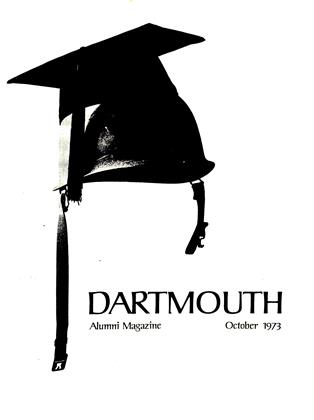"... ivory,/And apes and peacocks,/Sandalwood, cedarwood, and sweet white wine." "... Tyne coal,/Road-rails, pig-lead,/Firewood, iron-ware, and cheap tin trays."
Apes and peacocks are scarce commodities on the wharfs of Toledo, Ohio, though there's coal and ore and manufactured goods a-plenty. Volkswagens hardly match sandalwood for exoticism, and a 1000-foot "laker" or a cargo liner with derrick booms fore and aft bears little resemblance to Masefield's "stately Spanish galleon" or his "dirty British coaster with the saltcaked smoke-stack butting through the Channel in the mad March days." But the excitement, the pace - the romance, if you will - of water-borne commerce remain.
If cargoes and vessels have changed, so has management. JOHN A. McWILLIAM '52, general manager of the Toledo-Lucas County Port Authority, is the prototype young executive of the '7os efficient, hard-working, personable, his legal training evident in his approach to the varied challenges of the second busiest port on "America's fourth seacoast."
McWilliam, at 43 the second youngest president of the hemisphere-wide, 125-member American Association of Port Authorities, runs a complex operation which includes two Toledo airports as well as the new, still expanding 135-acre port facility at the mouth of the Maumee River.
The combined city-county authority was established in 1955, in anticipation of the 1959 opening of the St. Lawrence Seaway, which permits large vessels to penetrate deep into the continent, 2342 miles from open sea. The Seaway's locks, combined with those of the older Welland Canal around Niagara Falls, raises ships 602 feet above sea level by the time they reach the waters of Lake Erie.
Toledo enjoys a strategic location, within 500 miles of more than half the U.S. population, easily accessible for both domestic and foreign trade - as McWilliam and his promotional staff are quick to point out. Close to the coal mines of Kentucky and West Virginia, the steel mills of Ohio and Pennsylvania, and the grain fields of the Midwest, the city is a focal point for rail lines and a network of super highways. Grain elevators, oil refineries and storage tanks dot the downstream shores of the Maumee.
A gross tonnage of almost 25 million passed through the port in 1972, the bulk of it in coal from the south and iron ore from the mines along Lake Superior, far to the north and west. Annual grain exports, largely in corn and soy beans, recently surpassed 91 million bushels.
Ships sailing under the flags of 22 nations tied up last year at the port's almost mile-long berthing wharf, where giant gantry cranes mounted on railroad tracks unloaded such general cargo as 42.500 Volkswagens from West Germany. Owing to Toledo's first major dockside labor dispute since the new facilities opened in 1959, tonnage was off somewhat from 1971, a bumper year boosted by diversion of ships from strike-bound Atlantic ports.
A Toledo native, McWilliam returned home after graduation to join Gulf Oil. On completing evening law studies at the University of Toledo in 1956, he became an attorney for Gulf. He moved to the Port Authority as staff attorney in 1958 and was named chief executive officer in 1970.
Working under a nine-member board of directors four appointed by the city, four by the county, with one a joint appointment McWilliam supervises an annual budget of about five and a quarter million dollars. Port development is financed by country-wide levies; working revenue comes from rentals from private companies which operate the port's facilities and equipment. The airports, which came under the authority's management last year, are leased from the city for a dollar a year, with Toledo providing previously budgeted funds for expansion.
Civic pride is endemic in Toledo, and its citizens are almost personally involved in the port. The largest of six gantry cranes, a towering giant with a lift capacity of 110 tons, visible from afar across the flat landscape of northwestern Ohio, has been affectionately dubbed "Big Lucas"; its next junior, "Little Lucas." For the past several years, local television news each Saturday has included a special report on ships in port and cargo unloaded that week.
The involvement is mutual, and McWilliam devotes con- siderable time to church and community affairs. He's had to curtail participation recently, with the added demands of the AAPA presidency and his membership on the federally funded Winter Navigation Board, a group studying the feasibility of lengthening the Seaway's shipping season, which now extends from early April to about mid-December.
McWilliam has that rare capacity for compartmentalizing the various facets of his life. A five-handicap golfer, he plays as intensely as he works, putting the problems of the port aside from those of the sandtrap and the tricky green. His staff learns of tournament triumphs only from the newspapers. The entire family - Mr. and Mrs. McWilliam, a daughter at Ohio State and two younger children at DeVilbiss High School, where their parents were students together - enjoys skiing on nearby Michigan slopes.
At the office too, it's 100 percent concentration on promoting the Port of Toledo and making sure the customers, from Duluth or Denmark, find the operation as smooth as it's billed.
 View Full Issue
View Full Issue
More From This Issue
-
 Feature
FeatureCITIZEN SOLDIERS
October 1973 By LAURENCE I. RADWAY -
 Feature
FeatureONE HUNDRED MASTER DRAWINGS
October 1973 By ROBERT B. GRAHAM '40 -
 Feature
FeaturePeregrine Summer
October 1973 By James T. Harris '72 -
 Feature
FeatureArcheological "Amateur"
October 1973 -
 Article
ArticleBig Green Teams
October 1973 By JACK DEGANGE -
 Class Notes
Class Notes1973
October 1973 By STEPHEN H. QUIGLEY, JAMES T. BROWN
M.B.R.
Features
-
 Feature
FeatureDartmouth Regulars
April 1941 -
 Feature
FeatureWe asked some students: WHAT ONE THING WOULD YOU CHANGE ABOUT DARTMOUTH?
FEBRUARY 1991 -
 Feature
FeatureBRUCE SACERDOTE '90
Sept/Oct 2010 -
 Feature
FeatureES 21
January 1977 By DAN NELSON -
 Feature
FeatureSenior Valedictory
JULY 1973 By DOUGLAS A. JABS '73 -
 Cover Story
Cover StoryHOW TO GREEN UP YOUR KITCHEN
Jan/Feb 2009 By JENNIFER ROBERTS '84







